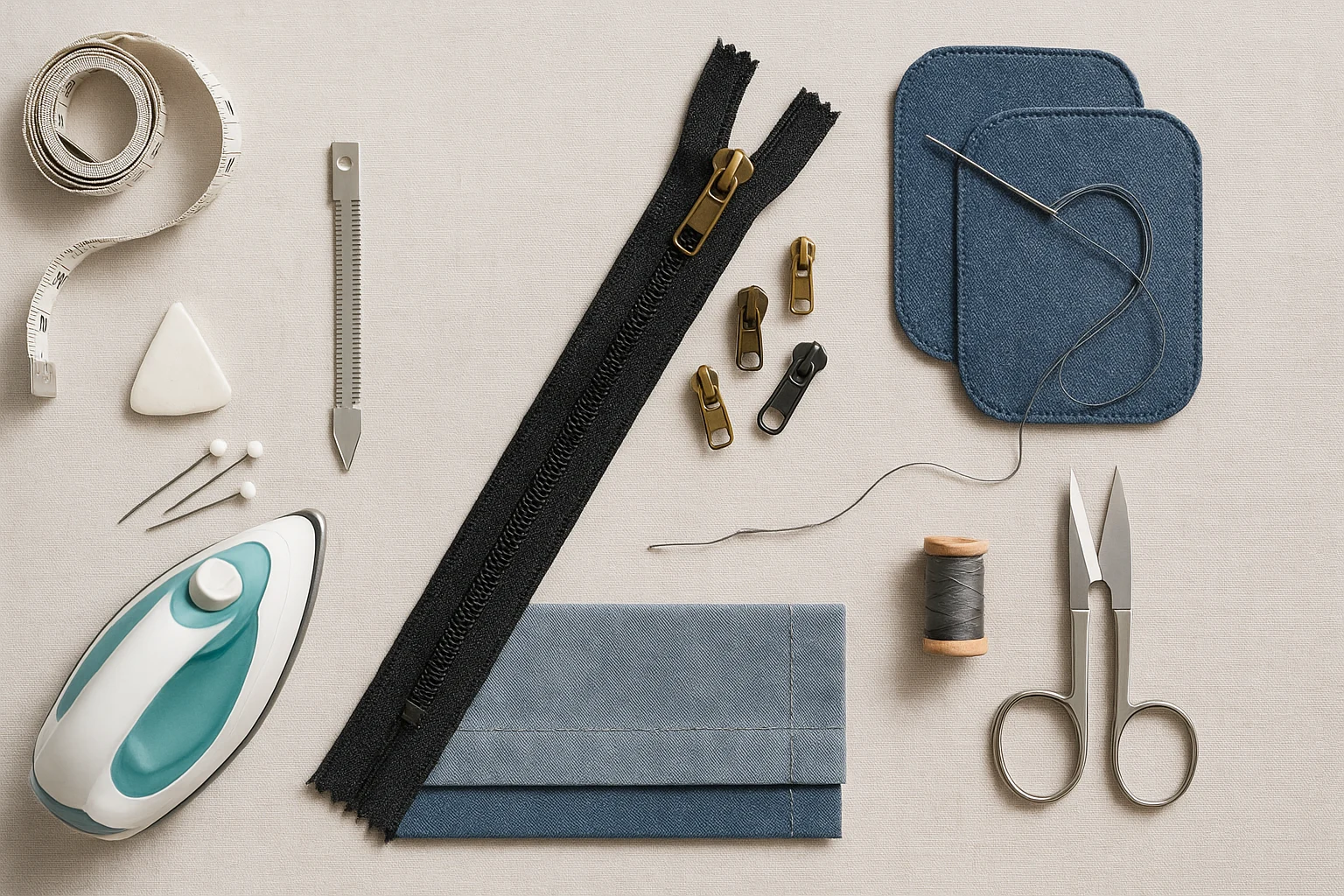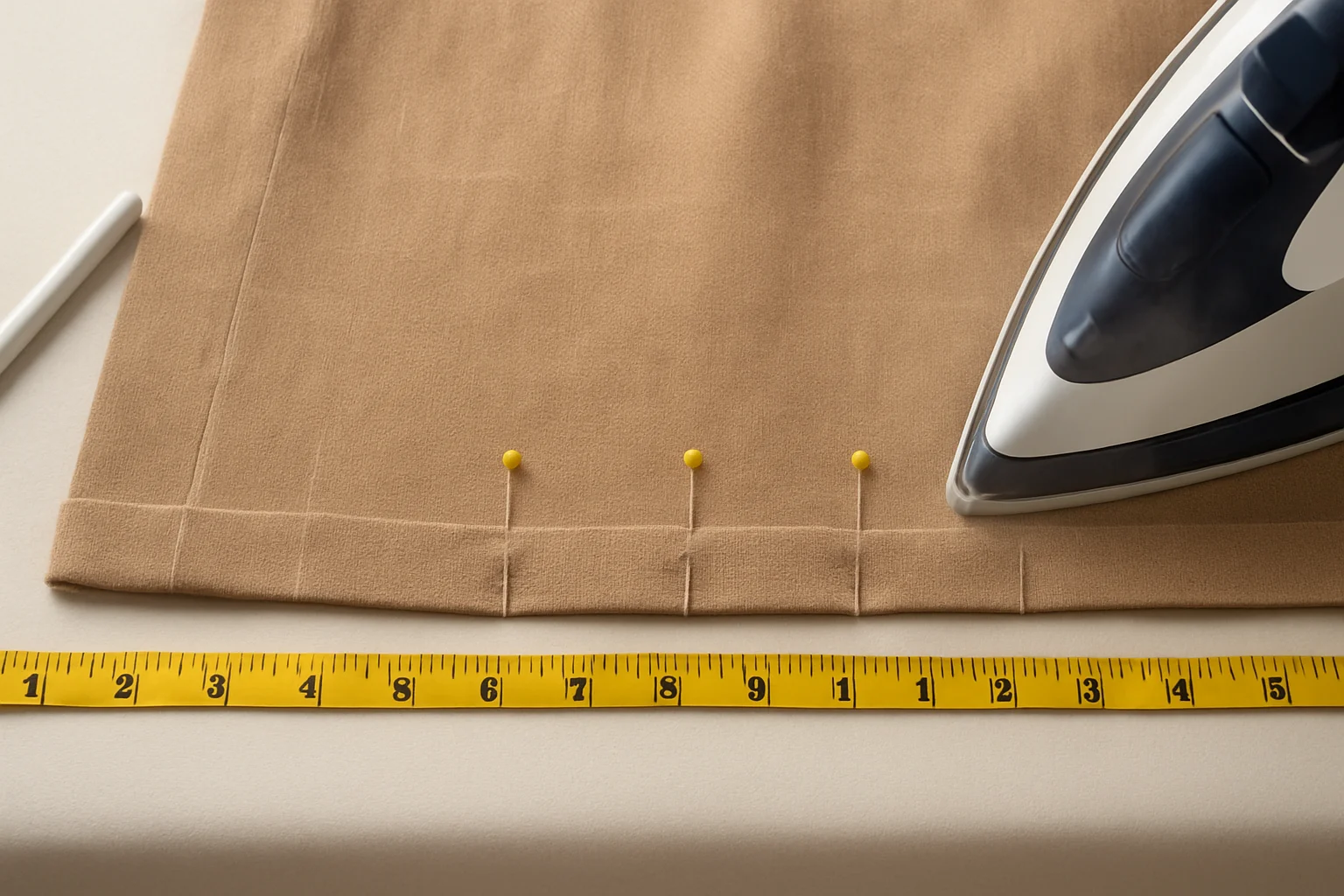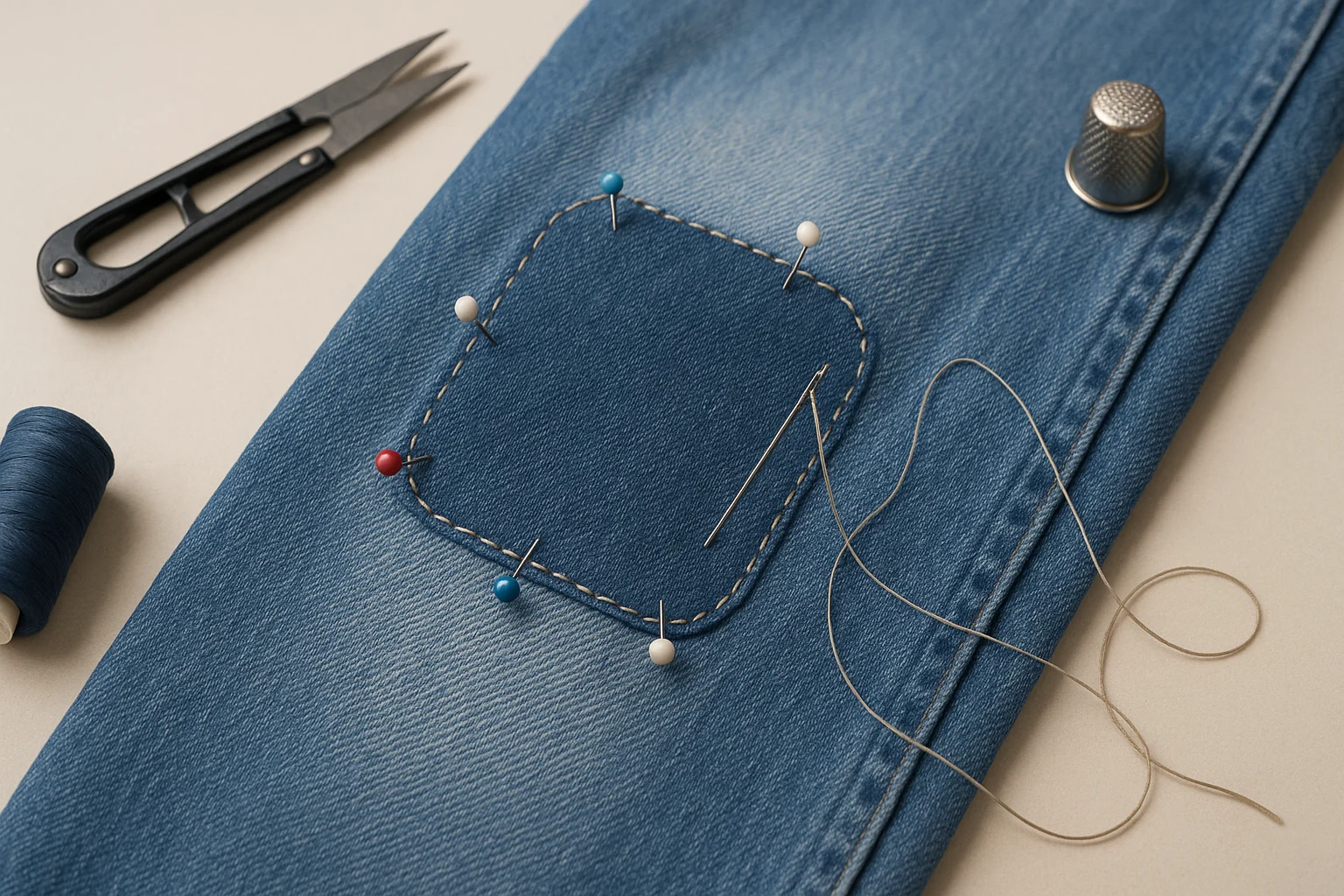
Got a fallen hem or a zipper that won’t budge? With a few basics and a little practice, you can bring favorites back into rotation—no pricey trip to the tailor. This guide focuses on fast, reliable clothing repair: choosing the right hem, knowing when a zipper needs only a slider, the simplest patch that lasts, and when it’s smarter to call a pro. Save money, cut waste, and keep the pieces you love. For broader wardrobe strategy, see our Frugal Fashion guide—and if you’re learning how to repair clothing, start with simple hems, buttons, and patches.
Safety first: unplug irons when not in use, protect surfaces, and test heat or adhesives on a hidden spot before committing.
Your Best-Fit Clothing Repair Tool
Tap through a few quick questions for a tailor-made fix.
Question 1/4
What’s going wrong?
What fabric are you fixing?
How much time do you have?
What tools do you have?
Your best next step
💡
Quick picks to get started—one compact starter kit, one heavy-duty set for rugged fabrics, and one stocked home kit.
Top repair kits for fast fixes
Top 3Cover day-one mending, rugged materials, and a stocked home setup—so you can fix hems, buttons, rips, and tough seams with confidence.
Vellostar Sewing Kit
All-in-one basics for buttons, quick hems, and simple patches—no machine needed.
- Best for: Beginners & everyday mends
- Format: Needles, threads, scissors, notions in a zip case
PLANTIONAL Upholstery Repair Kit
Tackle tough materials—denim, canvas, leather—with curved/tri needles and an awl for sturdy seams and patches.
- Best for: Rugged fabrics, bags, outerwear
- Format: 47-piece set: heavy needles, awl, threads, thimble, tape, scissors
Marcoon Large Sewing Kit
A well-stocked case with extra spools and tools—ideal as your at-home repair hub.
- Best for: Frequent mending & family use
- Format: 41 thread spools + 150+ accessories
This page contains paid/affiliate links. As an Amazon Associate we earn from qualifying purchases, and we may earn commissions from other partners—at no extra cost to you. Links marked with ‘#ad’ are affiliate links, meaning we may earn a commission at no extra cost to you. Learn more.
Table of Contents
- Key Takeaways
- Why Mend? Benefits of Fixing Your Clothes
- Essential Tools for Your Clothing Repair Kit
- Hems: Quick Method Picker (Single, Double, Blind, No-Sew)
- Button Up! Reattaching & Replacing Fasteners
- Tackling Tears & Rips: Patching Strategies
- Zippers: Diagnose Fast — Slider Swap vs. Full Replacement
- Fabric Focus: Repairing Different Materials
- When to Call a Pro: Find a Local Clothing Repair Shop
- Frequently Asked Questions
- Conclusion: Embrace the Art of Mending in 2025
Key Takeaways
- Save & waste less: Simple repairs keep clothes in use and out of landfills.
- Starter kit is small: Seam ripper, needles, thread, scissors, measuring tape, iron.
- Easy wins first: Hemming, buttons, and basic patches build confidence fast.
- Zippers aren’t scary: Many issues need only a new slider—check before replacing.
- Know limits: Delicate, complex, or structural fixes often deserve a pro.
Why Mend? Benefits of Fixing Your Clothes
Clothing repair saves money and reduces waste. A knee patch or quick hem can extend a favorite piece for years, avoiding a $50–$100 replacement and cutting textile trash.
Repairing also feels good—keeping a garment’s story going and learning a skill you’ll use again. Think of each mend as a small, sustainable upgrade to your wardrobe.

Essential Tools for Your Clothing Repair Kit
You don’t need a fancy sewing machine or a full tailor’s setup to start mending clothes. A simple, well-stocked kit of hand tools will get you through most common fixes.
Needles 70/10–80/12 for light fabrics, 90/14 for denim; ballpoint for knits. Polyester all-purpose thread suits most garments. Start with low iron heat on synthetics and test on a hidden area.
Here’s what you’ll want to gather:
| Tool Name | Primary Use | Why You Need It |
|---|---|---|
| Seam Ripper | Unpicking stitches, removing old seams | Helps prevent fabric damage when correcting mistakes or altering. |
| Hand Needles | All hand sewing tasks | Essential for stitching buttons, mending tears, and hems. |
| Assorted Thread | Matching fabric colors, creating strong stitches | Provides the material for all your sewing repairs. |
| Fabric Scissors | Cutting fabric cleanly and precisely | Ensures neat edges and accurate cuts without fraying. |
| Measuring Tape | Accurate sizing for hems, patches | Helps your repairs fit properly. |
| Iron & Board | Pressing seams, setting fusible products | Creates crisp, professional-looking finishes. |
Hems: Quick Method Picker (Single, Double, Blind, No-Sew)
Pick your hem fast: casual cottons/denim → double-fold, 1″ allowance; dress pants/skirts → blind hem, 1.5–2″ allowance. In a rush or no machine? Fusible web on stable wovens; test heat first. Silks and delicates → hand stitch with a fine needle.
How to Make Alterations on a Dress (Quick Start)
Wondering how to make alterations on a dress? Pin the hem while you’re wearing the dress, mark your ideal length, then press and try a few loose test stitches. Happy with the fall and movement? Finish with a blind stitch or a clean double-fold hem.
3.1 Measuring and Marking Your New Hem
- Try it On: Put on the garment and the shoes you’ll typically wear with it.
- Get Help (Optional): Ask a friend to help; stand naturally.
- Mark the Length: Pin the desired finished length evenly around.
- Flatten & Measure: Lay flat, measure from original edge to pins.
- Add Allowance: Single 1″ (½” finished), Double 2″ (1″ finished), Blind 2.5–3″.
- Cut Excess: Trim if very long, leaving your allowance.
3.2 The Single-Fold Hem (Basic & Quick)
- Press, pin, stitch: Turn up ½”, press; turn again if you want the edge enclosed; pin and stitch near the fold (hand or machine). Backstitch to secure.
3.3 The Blind Hem (Invisible Look)
- Prepare: Turn raw edge ¼”, then turn up the finished width and press.
- Fold Back: Fold the allowance toward the right side, leaving a small lip.
- Stitch: Take tiny pick-up stitches in the main fabric, alternating with stitches along the hem fold. Keep tension light to avoid puckers.
- Press: Unfold and press flat; stitches should barely show.
“A well-executed hem can transform an ill-fitting garment into a perfectly tailored piece.”
Button Up! Reattaching & Replacing Fasteners
A missing button can render a shirt or coat unwearable. Luckily, replacing a button is one of the quickest and easiest clothing repairs.
4.1 Replacing a Lost Button
- Choose: Match a spare or buy a similar one.
- Mark: Align with the buttonhole and mark the spot.
- Thread: Double strand; knot ends.
- Sew: Two-hole → 4–6 passes; four-hole → “X” or parallel. Add a thread shank for thick fabrics.
- Secure: Knot on the wrong side.
4.2 Reinforcing Loose Buttons
- Re-sew: Stitch over the original pattern a few times.
- Knot: Finish firmly to prevent another pop-off.
Tackling Tears & Rips: Patching Strategies
Small rips, holes, or worn-through areas don’t have to mean the end for a garment. Patches are a practical, sometimes stylish, way to extend their life. For quick clothing tear repair, match the method to the fabric and wear.

Custom patches for visible mending
Turn a repair into style—match fabric or add a simple graphic. Upload a design or pick a clean, minimalist look.
5.1 Iron-On Patches
- Prep: Trim loose threads; tidy hole edges.
- Choose: Patch larger than the hole; inside for subtle, outside for decorative.
- Press: Use a pressing cloth; follow patch heat instructions; let cool.
- Reinforce: Stitch around edges for high-wear spots; gear tape helps on outerwear.
How to Fix a Hole in Clothes Without Sewing
Use fusible web or iron-on patches for small holes, or a thin fabric glue on the wrong side for non-structural areas. Test heat/adhesive first and let everything cool fully before wearing.
“A well-placed patch can become a design feature, not just a fix.”
5.2 Stitch-On Patches
- Prep: Tidy fray; shape large holes if needed.
- Position: Over or under the hole; pin.
- Stitch: Machine straight/zig-zag or hand running/whip/blanket around edges.
- Trim (optional): If inside patch, tidy the outer edge.
5.3 Mending Small Tears & Loose Seams
- Seam split: Turn inside out, align edges, sew along the original line; backstitch ends.
- Small knit hole (darn): Build a grid, then weave across to recreate fabric.
Zippers: Diagnose Fast — Slider Swap vs. Full Replacement
If you’re tackling a home clothing repair, zippers are often easier than they look—start with basic clothing zipper repair by checking the slider vs. the teeth.
Zippers, fast: Stuck? Check for caught fabric; free it and run a graphite pencil along the teeth. Separates behind the slider? Gently crimp the slider rails with pliers and test. Pull tab broken? Swap the slider. Teeth missing or tape torn? Replace the entire zipper. Match slider size (e.g., #5 coil) and type—coil, metal, or molded.
6.1 Common Zipper Problems
- Stuck: Slider won’t move (often fabric caught).
- Separating teeth: Closes, then pops open behind the slider.
- Missing teeth/torn tape: Usually needs full replacement.
- Broken pull tab/loose slider: Replace the slider.
6.2 Slider Swap vs. Full Zipper Replacement
Slider swap: Teeth/tape intact but slider loose or separating → new slider often fixes it. Full replacement: Torn tape or missing teeth → replace whole zipper.
6.3 How to Replace a Zipper Slider
- Type: Separating (jacket) or closed-end (pants)?
- Remove stops: Lift top stops with pliers (closed-end) or pull slider off the top (separating).
- Match: Size/type on the slider back (e.g., “5C”).
- Attach: Thread tape ends into the new slider; test.
- New stops: Crimp above the rest point; test again.
Need a refresher on zipper parts? See this quick reference.
Fabric Focus: Repairing Different Materials
- Denim: Iron-on patches work for knees/elbows; stitch-on or darning lasts longer. 👖
- Knits: Use stretch-friendly stitches; avoid tight tension to prevent puckers.
- Delicates (silk, chiffon, rayon): Very fine needles and light hand-stitching; consider a pro for bigger damage.
- Synthetics: Can melt—test low heat first.
- Wool/Tweed: Traditional darning; match patch weight.
When to Call a Pro: Find a Local Clothing Repair Shop
If you find yourself typing clothing repair shop near me, call first and ask about slider swaps, invisible mending, and turnaround time. A quick phone chat can help you avoid paying for a full replacement when a simpler fix will do. You can also search clothing repair service near me and compare turnaround times.
- Complex alterations: Resizing a jacket, intricate darts, or major structure.
- Delicate/expensive fabrics: Silk, lace, leather, suede, or heavy embellishment.
- Invisible repairs: Reweaving or invisible mending in prominent areas.
- Heavy-duty repairs: Leather zippers, ripped linings, structural damage.
Before you decide, get a quote. A professional repair is often more affordable than buying new, especially for quality pieces you love. Do dry cleaners repair clothes? Many offer minor fixes like buttons and small hems—call to confirm.
Frequently Asked Questions
Make your mend look intentional
Finish with a patch that suits your garment and taste. Preview sizing before you order—keep it simple and neat.
Conclusion: Embrace the Art of Mending in 2025
Learning basic clothing repair is a valuable skill for anyone in 2025. It starts with a few simple tools and the willingness to try. You’ll likely save money and gain confidence as you extend the life of your garments. For a broader savings roadmap beyond clothes, see the Frugal Living Handbook.
This clothing repair guide is for general education only and isn’t professional, legal, medical, or safety advice. Use caution with heat, adhesives, and sharp tools; follow manufacturer instructions. For delicate, heirloom, leather, or complex garments, consult a professional tailor.